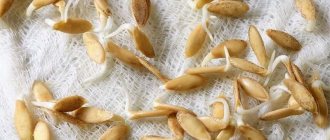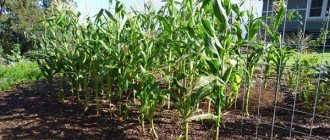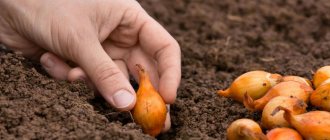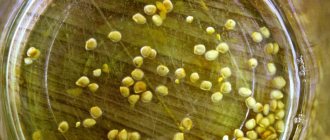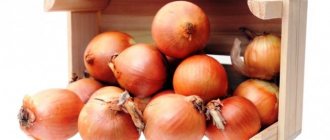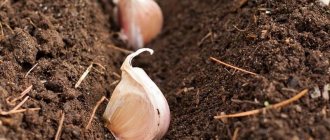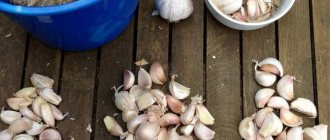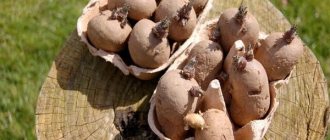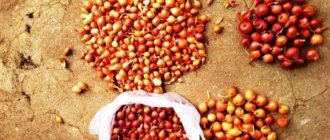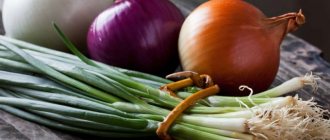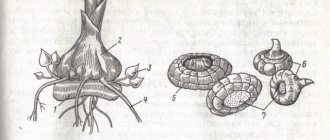Why is corn germination necessary?
Sprouting corn is advisable when it is necessary to obtain results ahead of schedule. Germinating the seeds makes the shell soft, so sprouts appear faster.
Benefits of germinating seeds:
- you can select the largest seeds;
- sprouted grains will definitely sprout;
- at home you can harvest throughout the entire season. To do this, it is necessary to plant the seeds at different periods;
- grains germinate evenly.
Sprouted corn has a high germination rate; experienced summer residents also note that such material increases the quantity and quality of the harvest.
What conditions are required for corn seed germination?
To obtain high-quality planting material, you need to know what conditions are required for the germination of corn seeds. It is recommended to follow the following tips:
- Use melt water. Rainwater can be used to increase the germination of corn. You can also freeze the required volume of liquid and leave it overnight to thaw.
- Use a root formation stimulator. If you need to get corn sprouts quickly, special preparations are used. These include Kornevin, Zircon, Epin.
- Corn for germination is pre-soaked. This will speed up the appearance of sprouts.
- The liquid in which the seeds are located must be changed regularly.
After sprouts have formed on the seeds, it is necessary to immediately plant the crop. Often young shoots dry out and die even before planting in open ground.
Important. To prevent the crop from being subject to fungal diseases, it is recommended to treat the seed material with a light solution of manganese before soaking.
Conditions for germination must be optimal
Growing methods
Corn breeding technology is based on the basic principles of agricultural technology. Regardless of the scale of production (private farms or large agricultural lands), the plant is usually propagated by seed. This is a more cost-effective and productive method that allows you to get a bountiful harvest. The agroclimatic conditions of a particular area influence the choice of crop hybrid. They are classified among themselves according to their ripening time.
It is important to choose seeds from a responsible producer, certified according to European standards, who offers products that are pre-treated against soil pests and pathogens of typical diseases. The same hybrid can produce seeds that will differ in shape, size and fraction
What types of corn are there?
- Ordinary (sowing);
- Sugar;
- Waxy;
- Membranous;
- Bursting;
- Starchy;
- Siliceous;
- Dentoform;
- Semi-dentate;
- Sharp-nosed (nosed);
- Caragua.
What varieties and hybrids are there?
- Spirit;
- Sundance;
- Hopi (with purple seeds);
- Dobrynya;
- Rodriguez;
- Corypheus;
- Cromwell;
- Coulter;
- Clifton;
- Cubitus is new;
- Kiness;
- Silvinio;
- Cypress;
- Amamonte;
- Classics;
- Kilomeris new;
- Krebs;
- Krabas;
- Commandos;
- Hummingbird;
- Kerberos is new.
When choosing a particular hybrid or variety, consult with the seller about the compatibility of the crop with the climatic conditions in your region.
How to grow corn in the country from seeds?
In order for corn with large cobs to grow and grow tall on a plot, it is not necessary to have a field of several hectares of land. However, keep in mind that the plant has its own characteristics:
- Maize is monoecious and has dioecious inflorescences;
- Pollination occurs cross-pollination;
- The plant has a strong root system that can go 1.5 meters into the soil;
- It also forms supporting roots, which serve to increase the resistance of the stem and transport water and minerals;
- The stem can reach six meters in height;
- The corn inflorescence is a complex ear. Female flowers are hidden in the leaf axils, while male flowers are panicles at the top.
Growing maize on a personal plot begins with processing the planting material. First, the seeds are calibrated by size. The larger it is, the better for the harvest. The external condition of the shell (there should be no damage) and the color saturation of the grain are also assessed. The germination test is performed by soaking in a weak salt solution for 5 to 10 minutes. Grains that have sunk to the bottom are suitable for sowing, those remaining on the surface are not.
To protect against diseases, seeds are pickled in a solution of hydrogen peroxide or potassium permanganate. Some people use powdered pesticide dissolved in water. Hydrothermal treatment is also required alternately in hot and cold water for 20 - 25 minutes.
When the seeds have undergone all the necessary preparation, you can begin the main sowing activities.
How to germinate corn at home before planting in the ground
How to germinate corn before planting? In this case, the following recommendations must be followed:
- Before germinating corn seeds, they must be carefully inspected and damaged ones removed. Otherwise, after sowing, the crop may be susceptible to diseases.
- Pour water over the seeds so that the liquid completely covers the material. Leave for 10 hours.
- Drain the water and place the planting material in the refrigerator for several hours; this procedure is carried out to harden the culture.
- Prepare 3 pieces of fabric. Soak them in water and spread the seeds on cloths. Cover the top with a wet cloth. Spread the seeds again in a thin layer and cover with a layer of cloth.
Eating and storage
After germination, wheat is suitable for eating for about 2 days. Therefore, there is no need to stock up on it for future use. For one person, it is enough to prepare 4-5 tablespoons of cereals. The grains will swell, and the norm will be enough for 2 days (3 tablespoons per day). Sprouts are stored only in the refrigerator, in a closed container.
It is correct to consume sprouted wheat in its raw form, chewing thoroughly and drinking it if necessary.
Many people add sprouts to various dishes:
- vegetable and fruit cocktails;
- porridge;
- salads;
- soups.
It is very useful to combine sprouted grains with legumes:
- chickpeas,
- lentils,
- we wave.
Together they have a beneficial effect on the digestive system and are easier to digest. To improve the taste, sprouts are often mixed with honey, chopped dried fruits, and nuts. They are added to bread and pastries, in which they somewhat lose their benefits.
The only thing you should not eat sprouted wheat grains with is milk. Mixing these two products is fraught with indigestion, flatulence, and increased gas formation.
Sprouting wheat for food is one of the most affordable ways to diversify your diet and feed the body with useful substances. Cereals sprout quickly. You need to eat them daily, 1–3 tablespoons per day. Positive properties do not appear immediately. A noticeable improvement in well-being usually occurs on the 14th–21st day of regular use of the sprouts.
How many days does it take for corn seeds to sprout?
Before you start soaking the seeds, it is important to find out how many days it takes for corn seeds to germinate. When planting seeds in open ground, the first shoots can be observed only after 12-14 days. However, the crop can sprout only under optimal weather conditions.
If there is a drought, life in the crop will not be observed soon. Therefore, many gardeners soak the seeds before planting. Pre-germination allows sprouts to appear within 6-7 days.
Attention! If you add Kornevin or aloe juice to the water, the first shoots can be obtained after 5 days.
How to care for corn seedlings
In order for seedlings to grow quickly and not become lethargic, they must be properly cared for. It is recommended to follow simple tips:
- After the first shoots appear, the film should be removed. This is done so that the plant does not get burned and receives the required amount of oxygen.
- It is necessary to water the seedlings by spraying every 2 days. It is important to ensure that water does not accumulate in the pan. Since this can lead to rotting of the roots.
- Harden the seedlings by placing them on the balcony for a few minutes. In a private house, seedlings can be taken outside. Gradually, the hardening period must be increased.
- If the seedlings are weak, it is necessary to feed the crop with nitrogen and phosphorus. This fertilizer will stimulate plant growth. For seedlings, you need to dissolve a small amount of fertilizer and water carefully.
How to transplant seedlings into open ground
It is necessary to transplant seedlings into open ground 18-25 days after the sprouts appear. The height of the seedlings must be at least 15 cm. The procedure for placing young corn in open ground can be carried out according to the following algorithm:
- The area must be carefully dug up and leveled with a rake. Add humus in the proportion of 1 bucket per square meter.
- Make planting holes no more than 15 cm deep.
- Water the seedlings with warm water before transplanting. Remove from the cup and place in the hole. If the seedlings were grown in peat cups, the planting material is installed along with the cup.
- The distance between the crops should be at least 15 cm. Since during the growth process the root system expands and too dense plantings reduce the amount of yield.
- Sprinkle the planting material with soil and compact it a little.
- Pour over warm water.
In cold regions, it is recommended to plant seedlings under film. This protection reduces the risk of leaf damage.
When growing a crop, you need to know not only how to prepare planting material, but also how long corn germinates. Because young plants need to be planted in the ground on time, since overgrown sprouts dry out quickly and may not take root on the site in the future.
Care after landing
Rapid growth of the crop is observed right up to the moment of flowering. The growth of green mass per day can be up to 12 cm. Then the plants devote all their strength to forming cobs. Caring for corn is simple and consists of the following activities:
- Watering. Although corn is a drought-tolerant plant, it requires deep watering at certain points in its life. With enough moisture, the kernels on the cob will be full, juicy and sweet. The first time the bed with crops is moistened abundantly, when 9 leaves are formed on the plants. The corn is then well watered during flowering. The third watering is necessary during the period when the grains are filled. After this, the soil should be moistened only if its top layer becomes excessively dry. You can install drip irrigation on the corn bed.
- Loosening. It should be done after every watering or rain. This procedure must be done especially carefully while the sprouts have not yet appeared above the surface. It is recommended to loosen the soil to a depth of no more than 4 cm. This procedure promotes the growth of additional roots and provides access to oxygen to the roots. Loosening is especially important at the beginning of the season.
- Hilling. This technique helps tall plants withstand gusts of wind, and also helps retain moisture in the ground. We can say that hilling partially replaces loosening. In addition, in hilled beds it is more difficult for weeds to break through, which means there is no need for weeding.
- Fertilizer application. The first feeding is carried out in the phase of appearance of 6 leaves. You can use both organic and chemical fertilizers. From organic matter you can take humus and compost. Ammonium nitrate solution or complex fertilizer will deliver minerals to the soil. A concentrated solution of Lingohumate is well suited for corn. It is used by diluting two tablespoons of the product in 10 liters of water. Apply 1 liter of the resulting fertilizer to each plant. At the moment the panicles appear, a second feeding consisting of mineral fertilizers is applied. The third time the plantings are fertilized during the formation of the cobs, using, for example, an Agricola-Vegeta solution.
Experienced summer residents have their own secrets of growing corn, which they are ready to share with other gardeners:
- Before planting, the corn bed should be dug to a depth of 30 cm, since this crop loves loose soil. Carrying out this procedure again after 2 weeks will eliminate the appearance of a large number of weeds.
- Acidic soil must be neutralized with lime, adding 3 kg of the substance per square meter of land. This will significantly improve yields.
- To obtain an early harvest, special early varieties and hybrids are best suited. Their plants are not tall and form cobs up to 30 cm in size.
- No matter how attractive the picture on the seed packaging may seem, you should choose zoned varieties intended for cultivation in a specific area.
- If you plant corn along the perimeter of the plot in a narrow strip, it will act as a hedge.
- In the second half of summer, side shoots - stepsons - form on the plants. They should be ruthlessly removed, only then can you count on a high-quality harvest. The grown shoots are broken off or cut off.
- If the flowering period occurs in damp, cool weather, pollination may not be complete and the process can be helped artificially. You should cut off the male flowers (sultanas) and shake off the pollen from them above the cobs.
Although corn was considered a southern crop, it is now successfully grown in the middle zone and even colder regions. The main thing is to use the right variety and follow the rules.
